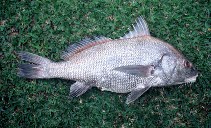| Family: |
Sciaenidae (Drums or croakers) |
| Max. size: |
170 cm TL (male/unsexed); max.weight: 51 kg; max. reported age: 43 years |
| Environment: |
demersal; brackish; marine; depth range - 10 m, oceanodromous |
| Distribution: |
Western Atlantic: Nova Scotia (Ref. 7251) to Florida, Gulf of Mexico, the Antilles (uncommon), and the southern Caribbean coast; also from the Orinoco delta to Argentina. |
| Diagnosis: |
Dorsal spines (total): 11-11; Dorsal soft rays (total): 19-22; Anal spines: 2-2; Anal soft rays: 5-7. Silvery grey to very dark, young with 4 or 5 black vertical bars on sides, disappearing with growth; pelvic and anal fins usually dark. Chin with 5 pores and 10 to 13 pairs of small barbels along median edges of lower jaws and subopercles, increasing in length posteriorly. Gas bladder with numerous lateral appendages interconnected in a complicated pattern in adult. Sagitta semicircular and moderately thin (Ref 51721). |
| Biology: |
Found usually over sand and sandy mud bottoms in coastal waters, especially in areas with large river runoffs. Juveniles often enter estuaries. Feeds mainly on crustaceans, mollusks and fishes. |
| IUCN Red List Status: |
Least Concern (LC); Date assessed: 30 July 2019 Ref. (130435)
|
| Threat to humans: |
harmless |
| Country info: |
|
Source and more info: www.fishbase.org. For personal, classroom, and other internal use only. Not for publication.

